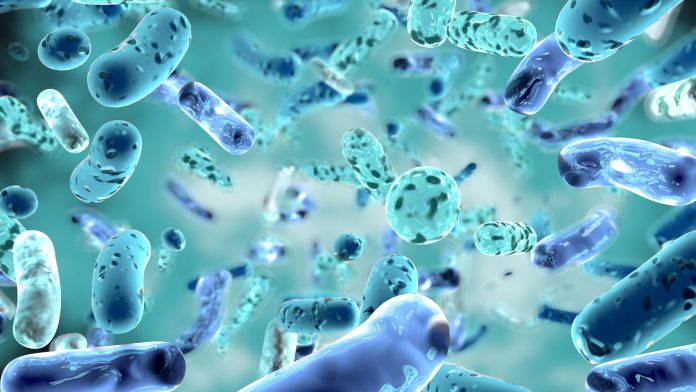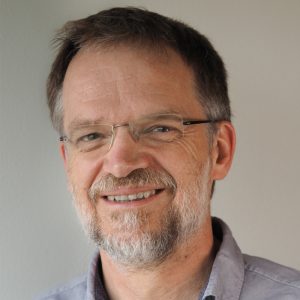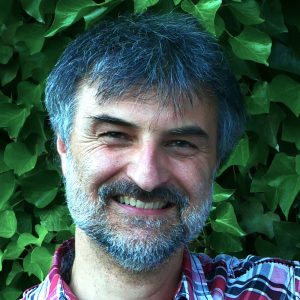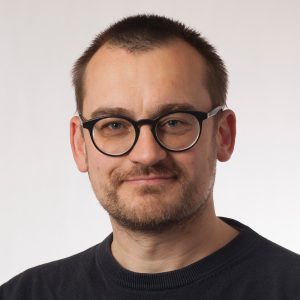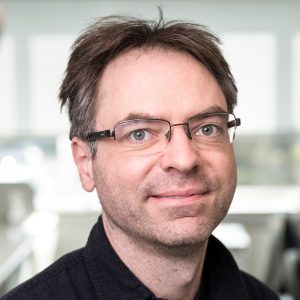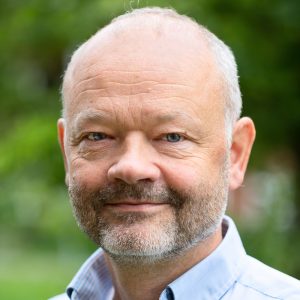The team at the Center for Electromicrobiology explain how they are directing their research to unravel the functions of cable bacteria.
Cable bacteria are centimetre-long, multicellular bacteria with internal, electrical wires. They are found in aquatic sediments and wet soils at oxic-anoxic interfaces. Here, they pick up electrons at the anoxic side and flare them off to oxygen at the oxic side. Numerous other types of bacteria are attracted by cable bacteria and seem to exploit their electric shortcut to oxygen.
Cable bacteria are a prominent example of a widespread phenomenon, as more and more microbial processes in nature appear to be mediated by electric currents between cells and minerals. The Center for Electromicrobiology (CEM) is dedicated to understanding this unique form of life. To achieve this goal and pave the way for future applications, the research at CEM is driven by three overarching questions along three main avenues.
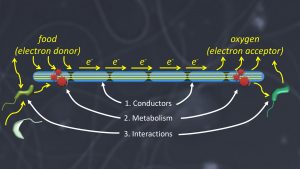
Conductors
Microbial, long-range electron transport implies the existence of highly conductive, bioorganic structures optimised by evolution through hundreds of millions of years. Which biological molecules are conducting electrons with such a high efficiency, and what is the underlying mechanism?
Metabolism
Having the metabolism of distant cells coupled via electron conductors is an intriguing property offering cable bacteria unique opportunities and special challenges. How does the metabolism of a multicellular organism, with electrically connected cells, function?
Interactions
When different microbial players directly interact via electrical currents, we must rethink ecological interactions and element cycling in nature. How do electrified ecosystems work?
The Center for Electromicrobiology is a Danish National Research Foundation Center of Excellence. Our research incorporates many fields of science and technology. We always welcome further collaborations and exchanges, among others in the following areas:
- Electromicrobiology;
- Molecular Biology;
- Electrochemistry;
- Microscopy;
- Biogeochemistry;
- Electronics;
- Electrophysics;
- Bioinformatics;
- Microbiology;
- Ecology;
- Engineering; and
- Modelling.
About us
- The Center for Electromicrobiology was established in 2017 with an expected operation time of ten plus years;
- Present team includes five staff scientists, four postdocs, six PhD students, four technicians, eight MSc and BSc students;
- Located on the city campus of Aarhus University at the Department of Biology, Department of Molecular Biology and Genetics, and the Interdisciplinary Nanoscience Center;
- State-of-the-art facilities in microbiology, molecular biology, biogeochemistry, microsensors, scanning probe microscopy and cryo-electron microscopy;
- Funded by Danish National Research Foundation with additional activities supported by Innovation Fund Denmark, Carlsberg Foundation, Novo Nordisk Foundation, Aarhus University Research Foundation, and Söll GmbH;
- Collaborations with research groups in Belgium, China, United States, Germany, Netherlands, United Kingdom, France, Austria, Australia, Sweden, Portugal, and Chile;
- 25 peer review papers (www.cem.au.dk); and
- Selected international exposures of CEM research;
o Science Magazine: ‘Electric mud’ teems with new, mysterious bacteria’ www.sciencemag.org/news/2020/08/electric-mud-teems-new-mysterious-bacteria
o New York Times: ‘Wired Bacteria Form Nature’s Power Grid: ‘We Have an
Electric Planet’ www.nytimes.com/2019/07/01/science/bacteria-microbes-electricity.html
o Seeker: ‘How These Bacteria Become Electrical Cables That Could Power
Our World’ www.youtube.com/watch?v=DPZTsGTL2nE
o Technology Networks: ‘Cable Bacteria Offer a Greener Way To Grow Rice’ www.technologynetworks.com/applied-sciences/news/cable-bacteria-offer-a-greener-way-to-grow-rice-333764
People
Lars Peter Nielsen, Professor and Head Of CEM
My scientific interest is microbial life at the border between the oxic and the anoxic world and that is where I accidentally came upon spurious electrical currents. At CEM, I strive to develop tools, experimental approaches and collaborations to support all three research avenues.
Andreas Schramm, Professor and Vice Head Of CEM
My areas of research are microbial ecophysiology and evolution, for example microbe-host interactions, cable bacteria, and microbes involved in aquatic nitrogen cycling and sediment biogeochemistry. At CEM, my current research focuses on the physiology and interactions of electrically conductive cable bacteria.
Thomas Boesen, Cryo-EM Facility Manager
I work with structural biology and advanced electron microscopy, investigating both bacterial nanowires and cable bacteria. My research is dedicated to resolving key cable bacteria structures and mechanisms to atomic level and linking them to the omics. This includes the identification and heterologous expression of genes related to unique properties of cable bacteria and associates.
Ian Marshall, Assistant Professor
I specialise in the sequencing and bioinformatic analysis of genomes and genes from microbes and microbial communities, and I am especially interested in the eco-physiological diversity of cable bacteria and microbes associated with cable bacteria.
Lars Riis Damgaard, Researcher/Academic Co-Worker
My main focus at CEM is technical experimental development and research, mainly within sensor techniques. Currently, I am applying myself as project leader in the innovation project BIOMAP (bio.au.dk/BIOMAP) on soil pollution and cable bacteria.
Before that, I was chief scientific officer at the microsensor company Unisense A/S.
Contacts
Center for Electromicrobiology, www.cem.au.dk
Center administrator Mette DE Jepsen, mettebj@bio.au.dk,
+45 9352 2346
Head of Center, professor Lars Peter Nielsen, lpn@bio.au.dk,
+45 6020 2654
Vicehead, professor Andreas Schramm, andreas.schramm@bio.au.dk, +45 6020 2659
Please note, this article will also appear in the sixth edition of our quarterly publication.

